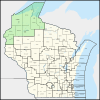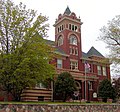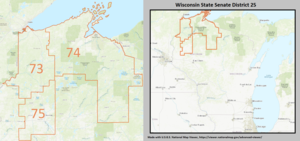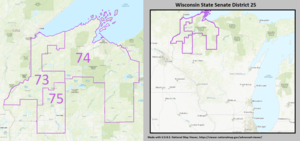
Area codes 715 and 534 are telephone area codes in the North American Numbering Plan (NANP) for the U.S. state of Wisconsin. The numbering plan area (NPA) comprises most of the northern part of the state. 715 was one of the original North American area codes created in 1947, while 534 was added in 2010 as an additional code for the same numbering plan area to form an overlay plan.

The United States District Court for the Western District of Wisconsin is a federal court in the Seventh Circuit.
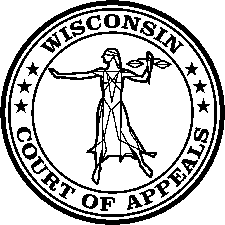
The Wisconsin Court of Appeals is an intermediate appellate court that reviews contested decisions of the Wisconsin circuit courts. The Court of Appeals was created in August 1978 to alleviate the Wisconsin Supreme Court's rising number of appellate cases. Published Court of Appeals opinions are considered binding precedent until overruled by the Supreme Court; unpublished opinions are not. The Court hears most appeals in three-judge panels, but appeals of circuit court decisions in misdemeanor, small claims, and municipal ordinance cases are decided by a single judge.
Wisconsin's 7th congressional district is a congressional district of the United States House of Representatives in northwestern and central Wisconsin; it is the largest congressional district in the state geographically, covering 20 counties, for a total of 18,787 sq mi. The district contains the following counties: Ashland, Barron, Bayfield, Burnett, St. Croix, Chippewa (partial), Clark, Douglas, Florence, Forest, Iron, Jackson (partial), Juneau (partial), Langlade, Lincoln, Marathon, Monroe (partial), Oneida, Polk, Price, Rusk, Sawyer, Taylor, Vilas, Washburn, and Wood (partial).

Janet Bewley is an American politician and former Democratic minority leader in the Wisconsin State Senate. She was a member of the Wisconsin Senate from 2015 through 2023, and previously served four years in the Wisconsin State Assembly, representing Iron, Ashland, Bayfield, and Price counties in the northwest of the state.
The 23rd Senate district of Wisconsin is one of 33 districts in the Wisconsin Senate. Located in northwest Wisconsin, the district comprises all of Barron, Clark, Price, Rusk, and Taylor counties, with most of Chippewa County, northern Dunn County, and parts of northwest Marathon County. The district is mostly rural, but contains the cities of Bloomer, Ladysmith, Medford, Neillsville, and Rice Lake.
The 28th Senate district of Wisconsin is one of 33 districts in the Wisconsin Senate. Located in southeast Wisconsin, the district comprises southeast Waukesha County and northwest Racine County. It includes the cities of Muskego, New Berlin, and most of the city of Waukesha, along with the villages of Big Bend, Mukwonago, and Waterford.

There are a variety of schema for dividing Wisconsin into regions.

The 1932 United States presidential election in Wisconsin was held on November 8, 1932 as part of the 1932 United States presidential election. State voters chose 12 electors to the Electoral College, who voted for president and vice president.
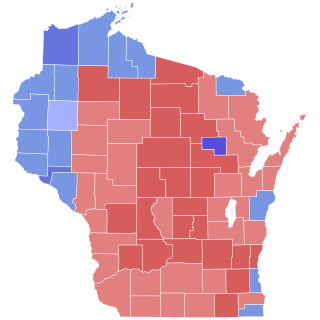
The 1978 Wisconsin gubernatorial election was held on November 7, 1978. Republican Lee S. Dreyfus won the election with 54% of the vote, winning his first term as Governor of Wisconsin and defeating incumbent Democrat Martin J. Schreiber. Bob Kasten unsuccessfully sought the Republican nomination.
The 27th Assembly district of Wisconsin is one of 99 districts in the Wisconsin State Assembly. Located in eastern Wisconsin, the district comprises much of Sheboygan County and parts of southeast Manitowoc County and northeast Fond du Lac County. It includes the cities of Sheboygan Falls, Plymouth, and Kiel, and the villages of Oostburg, Elkhart Lake, Howards Grove, and Kohler. It also contains Lakeland University, the Blackwolf Run golf course, the Road America motorsport course, and the Sheboygan County Memorial Airport. The district is represented by Republican Amy Binsfeld, since January 2023.

The One Hundred Fifth Wisconsin Legislature convened from January 4, 2021, to January 3, 2023, in regular session. The Legislature also held two extraordinary sessions and six special sessions during the term.

The 34th Assembly district of Wisconsin is one of 99 districts in the Wisconsin State Assembly. Located in northern Wisconsin, the district comprises all of Vilas County and most of Oneida County. It contains the cities of Rhinelander and Eagle River and most of the Lac du Flambeau Reservation. It also contains parts of the Nicolet National Forest, including the Blackjack Springs Wilderness. The district is represented by Republican Rob Swearingen, since January 2013.
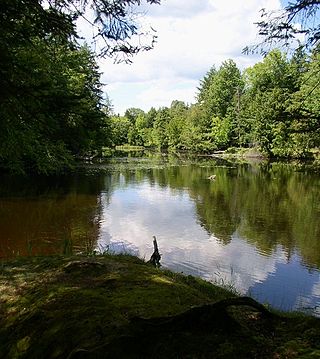
The 68th Assembly district of Wisconsin is one of 99 districts in the Wisconsin State Assembly. Located in northwestern Wisconsin, the district comprises all of Price and Rusk counties, and most of Chippewa and Taylor counties. It includes the cities of Bloomer, Cornell, Ladysmith, Park Falls, and Phillips, and the villages of Bruce, Catawba, Conrath, Gilman, Glen Flora, Hawkins, Ingram, Kennan, Lublin, Prentice, Rib Lake, Sheldon, Tony, and Weyerhaeuser. The district also contains Lake Wissota State Park, Brunet Island State Park, and Timms Hill—the highest natural point in the state of Wisconsin. The district is represented by Republican Karen Hurd, since January 2023.

The 73rd Assembly district of Wisconsin is one of 99 districts in the Wisconsin State Assembly. Located in the northwest corner of Wisconsin, the district comprises parts of northern Douglas County, northern Bayfield County, and northern Ashland County. It includes the cities of Superior, Ashland, Bayfield, and Washburn, and the villages of Oliver and Poplar. The district also contains the Bad River and Red Cliff Indian reservations, Apostle Islands National Lakeshore, Big Bay State Park, Pattison State Park, Amnicon Falls State Park, and the University of Wisconsin–Superior campus. The district is represented by Republican Angie Sapik, since January 2023.

The 74th Assembly district of Wisconsin is one of 99 districts in the Wisconsin State Assembly. Located in northwest Wisconsin, the district comprises all of Iron, Sawyer, and Washburn counties, along with most of Ashland County, the southern half of Bayfield County, the southern half of Douglas County, and part of northeast Burnett County. It includes the cities of Hayward, Hurley, Mellen, Montreal, Shell Lake, and Spooner, and the villages of Birchwood, Butternut, Couderay, Exeland, Mason, Minong, Radisson, Solon Springs, and Winter. The district also contains the and most of the Chequamegon National Forest. The district is represented by Republican Chanz Green, since January 2023.

The 75th Assembly district of Wisconsin is one of 99 districts in the Wisconsin State Assembly. Located in northwestern Wisconsin, the district comprises all of Polk County and most of Burnett County. It includes the cities of Amery and St. Croix Falls and the villages of Balsam Lake, Centuria, Clayton, Clear Lake, Dresser, Frederic, Grantsburg, Luck, Milltown, Osceola, Siren, and Webster, and part of the village of Turtle Lake. The district also contains the St. Croix Chippewa reservation, the Wisconsin portion of Interstate Park, and a significant portion of the Wisconsin side of the Saint Croix National Scenic Riverway. The district is represented by Republican David Armstrong, since January 2021. After the 2024 redistricting, Armstrong no longer resides in the new 75th district.

The 92nd Assembly district of Wisconsin is one of 99 districts in the Wisconsin State Assembly. Located in western Wisconsin, the district comprises parts of southwest Chippewa County and central Dunn County. It includes the cities of Chippewa Falls and Menomonie and the parts of Eau Claire which fall in Chippewa County, along with the villages of Elk Mound and Lake Hallie. The district is represented by Republican Treig Pronschinske, since January 2017.

The 1932 Wisconsin gubernatorial election was held on November 8, 1932. Incumbent Republican Governor Philip La Follette was defeated in the Republican primary, and in the midst of the Great Depression and nationwide voter dissatisfaction with the Republican Party, Democratic nominee Albert G. Schmedeman defeated Republican nominee Walter J. Kohler Sr. and Socialist nominee Frank Metcalfe with 52.48% of the vote. Schmedeman became the first Democrat to win a gubernatorial election in Wisconsin since George Wilbur Peck in 1892. Two years later, in 1934, La Follette would run for governor again and defeated Schmedeman, this time running with the Progressive Party.

The 2022 Wisconsin Senate elections were held on Tuesday, November 8, 2022. 17 of the 33 seats in the Wisconsin State Senate were up for election—the odd-numbered districts. This was the first election to take place after redistricting following the 2020 United States census. This was the only election to take place under the redistricting plan set out in 2022. Before the election, 21 Senate seats were held by Republicans, and 12 seats were held by Democrats. 11 Republican seats and six Democratic seats were up in this election. The primary election took place on August 9, 2022.
